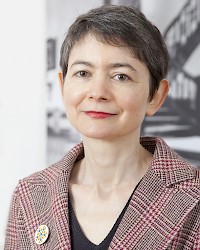Vita
Larisa Dryansky is Maître de conférences in the history of art at the University Paris-Sorbonne since 2012 and scientific consultant at the Institut national d’histoire de l’art (INHA) since September 2014. She studied philosophy at the University Paris IV Sorbonne and received her PhD from the University Paris 1 Panthéon-Sorbonne in 2011 with a thesis in history of art. Her PhD thesis dealt with the usage of cartography and photography in American art of the years 1960/1970. At the Institut national d’histoire de l’art she develops a reflection about new media from the perspective of history of art. Larisa Dryansky has been appointed at the École nationale supérieure des arts décoratifs, University Paris 8, University François-Rabelais in Tours and University Sorbonne-Nouvelle Paris III. She has worked at the Edwynn Houk Gallery, New York and Paris, for several years and has curated exhibitions at the Musée Nicéphore Niépce, Chalon-sur-Saône and Mémorial de la Shoah in Paris. Her work has been published in “Les Cahiers du Musée national d’art modern”, “Études photographiques”, “20/27” and “(Sic)” as well as in various collective anthologies and exposition catalogues.
Dated from 2016
Fields of research
Art of the 20th century; American art; arts and sciences; video art and experimental cinema; photography; cartography and art
IKKM Research Project
“Between Existence and Not.” Dispersion and Disintegration in the Work of John Latham
Spilling, scattering, tearing, shredding, and other such apparently destructive actions characterize many postwar artistic currents from action painting to Happenings, performance art, and “anti-form.” My research project seeks to contribute to the understanding of these processes by focusing on the work of the postwar British artist John Latham. Often identified as belonging to conceptual art broadly defined, Latham was among other things a participant in the Destruction in Art Symposium of 1966—a major event for understanding the role played by destructive forces in the art of the 1960s—, and, more generally, relied on dispersion and disintegration as key artistic processes for his work. Significant examples of this are the spray-gun paintings of the mid-1950s, the burnt and exploded Skoob Towers—sculptural pieces using books as primary material, which the artist created in the 1960s—, the spray-gun drawings of the Noit – One-Second Drawings series produced in the 1970s, as well as, it may be argued, Latham’s stop-animation films with their discontinuous rhythm. Taking as its inspiration a variety of scientific sources, Latham’s approach stands out, however, for its hermeticism and its high degree of abstraction. Indeed, Latham’s engagement with dispersion and disintegration, I argue, offers an alternative model to the more phenomenological practices of so-called “process art” and to the psychoanalytically-inflected discourse of formlessness that is in part the latter’s theoretical offshoot. Rather than a method for dissolving form, dispersion and disintegration were used by Latham to give shape to his own, idiosyncratic cosmology, one based on a new type of structure: a “time-based” structure that he termed “eventstructure.” Neither does Latham’s perspective conform to the common understanding of processual and materialistic approaches. While his art may be founded on the primacy of time over space, his strangely static and reversible conception of the temporal dimension and of events has little to do with naturalistic, experiential time. Similarly, while in pieces such as the spray-gun paintings and drawings or the burnt and maimed book reliefs and towers the materiality of the work appears to be emphasized, Latham’s purpose is in fact to render perceptible a kind of negative materiality or materiality in reverse, that is, not a mere dematerialization, but a suspended state, which, in his own words, “oscillates between existence and not.”
Publications
Monographs
Cartophotographies. De l’art conceptuel au Land Art, Paris, INHA/CTHS, coll. « L'art et l'essai », 2017.
Ilse Bing: Photography through the Looking Glass. New York: Abrams 2006.
Edited Books
with Samuel Bianchini, Erik Verhagen, Nathalie Delbard: Practicable. Cambridge, MA: MIT Press (forthcoming).
Articles
“Robert Smithson et la science comme fiction”. In: Céline Flécheux and Jean-Pierre Criqui (eds.): Robert Smithson. Entropie et mémoire. Dijon: Les Presses du Réel (forthcoming).
“Paléofuturisme. Robert Smithson entre préhistoire et posthistoire”. In: Rémi Labrusse, Maria Stavrinaki (eds.): Préhistoire/modernité, Special Issue: Les Cahiers du Musée national d’art moderne 126, 2013/2014, pp. 72-81.
“Sartrean Phenomenology and Postminimalism: On Some Works by Mel Bochner and Dan Graham”. In: Anaël Lejeune, Olivier Mignon, Raphaël Pirenne (eds.): French Theory and American Art. Brussels/Berlin: (SIC)/Sternberg Press 2013, pp. 136-161.
“Du ciel à la terre. Les earthworks et la vue aérienne”. In: Angela Lampe (ed.): Vue d’en haut. Metz: Centre Beaubourg 2013, pp. 308-317.
“‘Tra identità e analogia’. Luigi Ghirri e la fotografia americana”. In: Francesca Fabiani, Laura Gasparini, Giuliano Sergio (eds.): Luigi Ghirri. Pensare per immagini. Milan: Electa 2013, pp. 48-55.
“‘Le paysage c’est comme un visage’. Jean-Luc Godard et le courant New Topographics”. In: (SIC) 4, 2012, pp. 77-88.
“Images of Thought: The Films of Antonioni and Godard and the New Topographics Movement”. In: John Rohrbach, Gregory Foster-Rice (eds.): Reframing New Topographics. Chicago: The Center for American Places at Columbia College 2011, pp. 107-120.
“L’Ars memorandi de Hannah Höch”. In: Jean-Pierre Criqui (ed.): L’image déjà là. Usages de l’objet trouvé, photographie et cinéma. Special issue: Les Carnets du Bal 2, 2011, pp. 28-51.
“La Carte cristalline. Cartes et cristaux chez Robert Smithson”. In: Les Cahiers du Musée national d’art moderne 110, 2009/2010, pp. 62-85.
“Trajets dans la quatrième dimension. Temps et photographie dans l’art américain des années 1960”. In: Les Cahiers du Musée national d’art moderne 105, 2008, pp. 54-73.
“Le Musée George Eastman: Une autre photographie américaine?”. In: Études photographiques 21, 2007, pp. 74-93.
“Images stéréo. L’illusion dans l’oeuvre d’Ed Ruscha”. In: Les Cahiers du Musée national d’art moderne 99, 2007, pp. 32-51.
“Clichés d’architecture. La photographie d’Ed Ruscha et les sources de l’architecture postmoderne aux États-Unis”. In: Revue Histoire de l’art 59, 2006, pp. 129-139.
